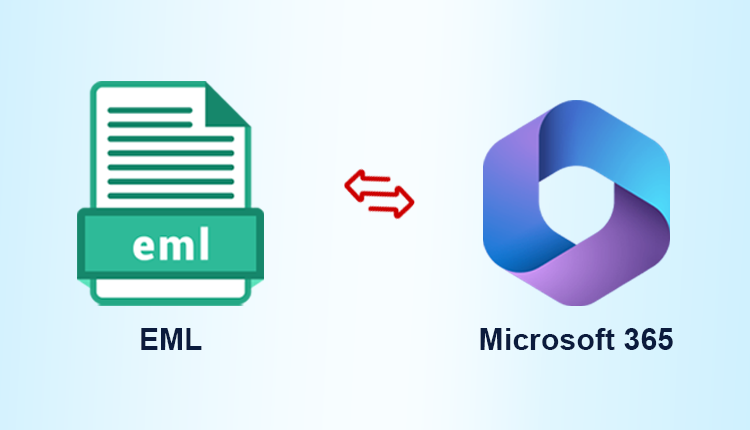Import EML to Office 365 – Simple Steps

If you want to move your emails from EML files into your Office 365 account to access them from the Outlook Web App, you’ll need to use a workaround. In this post, we’ll show you how to import EML to Office 365 mail client. This may be done with the help of EML to Office 365 Migrator. It is possible to upload and open EML files straight from your Office 365 account. The Migrate EML to Microsoft 365 is easy to use and is a reliable and painless choice for customers.
Table of Contents:
- What are EML Files?
- How to Import EML Files to Office 365
- Method 1: Use Outlook Desktop Client (Best for Migrating a Small Number of EML Files)
- Method 2: Drag & Drop Method – Migrate EML to Microsoft 365
- Limitations of the Process to Import EML to Office 365
- Using Automated Tool to Import EML to Office 365
- Step-by-step Method
- Conclusion
What are EML Files?
EML files are like containers that hold single email messages. They include everything in the email, like who sent it, who it was sent to, the subject, the body, any attachments, and how it’s formatted.
How to Import EML Files to Office 365
Since Office 365 doesn’t have a built-in way to import EML files, you’ll need to use a different method:
Method 1: Use Outlook Desktop Client (Best for Migrating a Small Number of EML Files)
For this method to import EML to Office 365, you’ll use the Outlook desktop app to move EML files to your Exchange Online mailbox.
Step 1: Get the Outlook Desktop Client — If you don’t have the Outlook desktop client, download and install a version that’s compatible with your computer’s operating system.
Step 2: Importing EML Files to Outlook — Open Outlook and find the mailbox folder where you want to add your EML files (e.g., Inbox). Drag your EML files from your computer and drop them into the chosen folder in Outlook.
Step 3: Exporting Mailbox to PST File — To export your mailbox as a PST file, use Outlook’s Import/Export Wizard. Go to “File” > “Open & Export” > “Import/Export.” Select “Export to a file” and choose “Outlook Data File (.pst).” Select the folder where the imported EML files are located.
Step 4: Adding PST Files to Office 365 Exchange Online — To import PST files into Office 365 Exchange Online through the Microsoft Network Upload method:
- Prepare PST Files: Ensure PST files are accessible.
- Install AzCopy: Download and install the Azure AzCopy tool.
- Upload to Azure: Use AzCopy to upload PST files to the Microsoft Azure storage location.
- Create CSV File: Map PST files to specific mailboxes in a CSV file.
- Start Import Job: Navigate to the Office 365 Security & Compliance Center and create a new import job under Data Governance > Import.
- Verify and Start: Verify PST files and mappings, then initiate the import process.
- Monitor Progress: Check the progress and confirm that all data is imported successfully.
Method 2: Drag & Drop Method – Migrate EML to Microsoft 365
Assuming you have all of the EML files on your hard drive,
- Open Microsoft Outlook.
- Create a new folder by right-clicking on the left panel.
- EML files are what you should call them.
- While Outlook is operating, open the folder holding your EML files on your computer.
- Choose all of the EML files.
- Drag and drop all of the EML files into the newly created Outlook folder (do it for 50 files at a time if you are having an issue).
EML emails will appear in Outlook once this is completed.
In certain circumstances, the imported emails’ body text is not shown in the Outlook interface. It means that this strategy isn’t right for you to import EML to Office 365.
Limitations of the Process to Import EML to Office 365
- Protracted and labor-intensive process.
- Lacks batch processing capabilities.
- Compatibility issues with EML file formats.
- Potential for data loss during import.
- Challenges with preserving metadata and attachments.
- Problems with mapping folder structures.
- Limited support for large EML files due to Office 365 size restrictions.
- Dependence on software updates and version compatibility.
- Absence of official support and documentation for EML imports.
- Risk of data loss during migration.
- Lack of automation and reporting features.
Using Automated Tool to Import EML to Office 365
SysTools Users may import EML to Office 365 accounts using EML to Office 365 Converter. It first asks users to choose an EML file folder, then loads all of the emails in the source folder. Migrating EML to Microsoft 365 account using this method does not require any technical knowledge because it only requires the resultant account’s Office 365 login credentials.
Step-by-step Method
- Download and Run the Software in your operating system.
- After that, add your EML file to the software.
- Now, you can get a complete preview of your EML data of the software.
- Then, click on the Export button and select Office 365.
- After that, enter a user login credential.
- Now, apply the filter and click the Export button to start the method.
- Finally, migrate EML to Microsoft 365.
Conclusion
Since there is no direct way to migrate EML to Microsoft 365, users should use an automated tool to import EML to Office 365 as a workaround, according to the post. It has established a step-by-step procedure for both choices that will guide customers through the process of uploading EML files to Office 365.